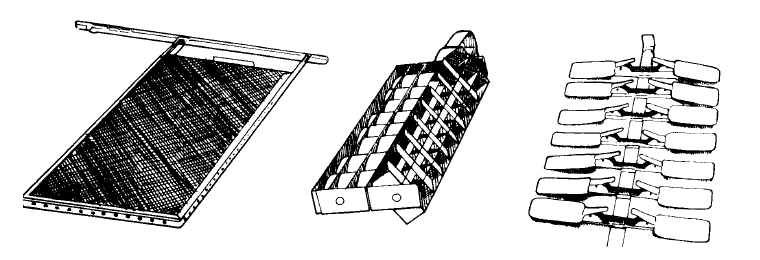DARKROOM
a. Construction. Since x-ray films are more sensitive to light than most photographic films, it is important to have a good darkroom. The room need not be large, but it must be constructed so that no light can enter through cracks or crevices. An entrance built in the form of a maze to keep out light is better than a door. If the darkroom has a door, it should have an inside lock so that no one can accidentally enter while films are being processed. The walls of the darkroom and the maze should be painted black to absorb light. The ceiling may be painted white so that enough illumination will be reflected when the correct type of safelight is used. The room should be supplied with both hot and cold water. The water pipes should lead to a mixing valve so the temperature of the flow can be regulated. Adequate ventilation must be provided. This can be done by forcibly changing the air with a ventilator fan.
b. Cleanliness. Because of the extreme sensitivity of x-ray films, rigid cleanliness must be observed when processing films.
Clean all equipment and only use for its intended purpose. The dental specialist must not spill chemicals. If chemicals are spilled, wipe up immediately and wash the
area with clear water. Spilled chemicals that are not wiped up will evaporate and leave a precipitated concentrate that contaminates films. Wash the thermometers
and film holders thoroughly before transferring them to either the developing or fixing solutions. Film hangers require particular attention after films have been removed
from them. If a hanger is not washed properly, the fixing solution dries on it. Then, when new films are placed on the hanger and immersed in the developing solution,
the dried fixing solution runs down onto the films and causes streaked or spotted radiographs. It also contaminates the developing solution.
c. Thermometer. Since films must be processed at an exact and predetermined temperature, a thermometer is needed to register the temperature of the solutions.
d. Timer. Because of the direct relationship between temperature and time in processing, the dental specialist must know the exact time and any given film is to be left in each solution. A good watch may be used for this purpose, but it is much better to use an interval timer. The interval timer is a small clock giving the time in minutes and fractions of minutes. When set for the exact time required for development, it sounds an alarm at the expiration of that time.
e. Film Holders. There are three types of film holders. The frame type is used for extraoral films and the clip and hinge types are used for intraoral films (see figure 3-2).

f. Illumination. A photographically safe light must be used to illuminate the darkroom. T he standard for a safelight is that it must be possible to permit underdeveloped film to be exposed to the light at a distance of 4 feet for 1 minute without the least evidence of fogging.
g. Sink. A sink is useful in the darkroom for mixing solutions, washing hands, and disposing of used chemicals.
Remember that the fixing solution is not disposed of like other chemicals. It is retained for silver recovery.
h. Solutions. There are two types of processing solutions. One is used for the automatic processor and another
for the manual processor. They are not designed to work interchangeably. Before changing the processing solutions, check the
manufacturers' instructions to be sure that you have the proper chemicals for the processor you are using. Also, follow manufacturers
instruction when preparing them. Some will require several chemicals mixed with water while others may be used directly from the container.